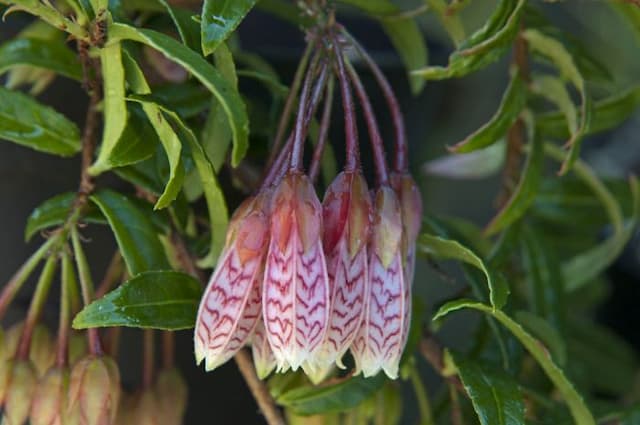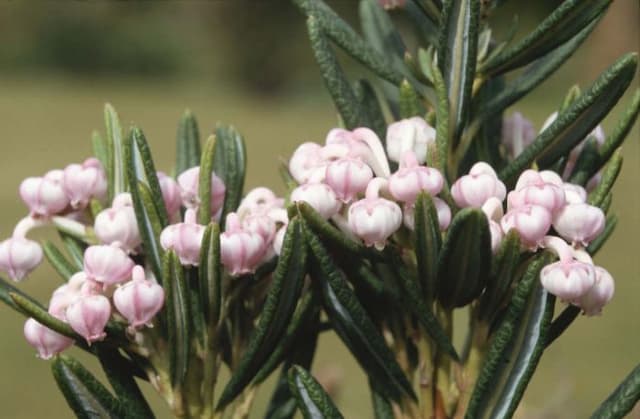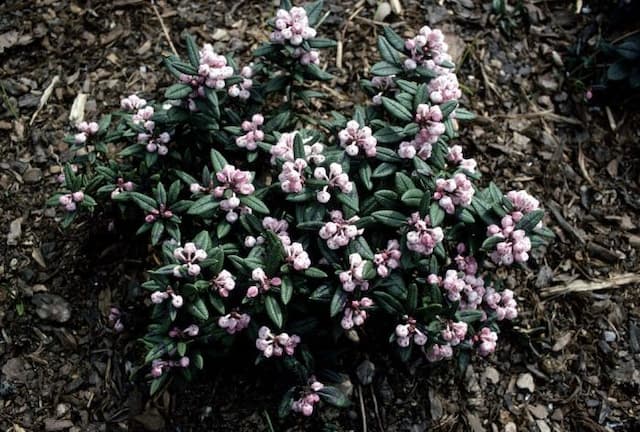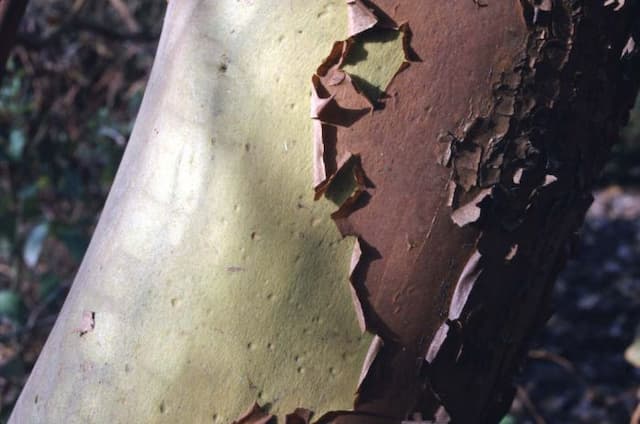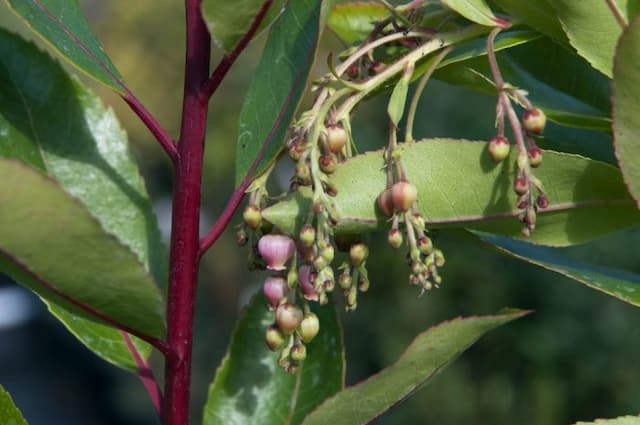Darley Dale Heath Erica × darleyensis f. albiflora 'White Spring Surprise'

ABOUT
'White Spring Surprise' is a flowering plant noted for its profusion of blooms, typically displayed during the spring. This particular variety is adorned with an abundance of small, bell-shaped flowers that are pure white in color, creating an eye-catching contrast against the green of its foliage. The leaves of 'White Spring Surprise' are needle-like in shape and arranged in whorls along the stems, presenting a dense and textured appearance. The plant's overall form is rounded and bushy, making it an attractive option for gardeners looking to add some floral interest to their landscape. The pure white blossoms not only add a bright spot of color but also may attract pollinators such as bees and butterflies, enhancing biodiversity in the garden.
About this plant
 Names
NamesFamily
Ericaceae
Synonyms
Darley Dale Heath, Winter Heath, Heather
Common names
Erica × darleyensis f. albiflora 'White Spring Surprise'.
 Toxicity
ToxicityTo humans
Darley Dale heath is generally considered non-toxic to humans. There are no well-documented cases of poisoning from this plant, and it is not known to contain harmful substances that would pose a risk if ingested in small quantities. However, as with any plant, individual allergies or sensitivities are possible, and it is generally advisable not to consume parts of ornamental plants without expert guidance.
To pets
Darley Dale heath is generally considered non-toxic to pets as well. It is not listed among plants that are known to cause harm to cats, dogs, or other domestic animals if ingested. Nevertheless, pet owners should always monitor their pets and prevent them from eating ornamental plants, as individual animals may have allergies or sensitivities, and excessive ingestion of non-food plants can sometimes lead to gastrointestinal upset or other health issues.
 Characteristics
CharacteristicsLife cycle
Perennials
Foliage type
Evergreen
Color of leaves
Green
Flower color
White
Height
1-2 feet (0.3-0.6 meters)
Spread
1-2 feet (0.3-0.6 meters)
Plant type
Shrub
Hardiness zones
7
Native area
Europe
Benefits
 General Benefits
General Benefits- Attracts Pollinators: Provides nectar for bees and other beneficial insects, enhancing local biodiversity.
- All-Year Interest: Offers visual appeal throughout all seasons with evergreen foliage and winter blooms.
- Low Maintenance: Requires minimal care once established, making it suitable for both novice and experienced gardeners.
- Drought Tolerance: Adapts well to dry conditions after establishing roots, reducing the need for frequent watering.
- Cold Hardy: Resistant to frost and can survive in cold climates, broadening its suitability across different regions.
- Erosion Control: Helps stabilize the soil with its root system, which is particularly beneficial on slopes or banks.
- Versatile Landscaping: Suitable for a variety of landscaping uses, including as ground cover, in rock gardens, or as border plants.
- Wildlife Shelter: Provides cover and protection for small wildlife, creating a habitat within the garden ecosystem.
- Color Variety: Brings seasonal color to the garden with its vibrant white flowers in the winter and spring months.
- Hybrid Vigor: As a hybrid, it may exhibit increased robustness and better overall performance than its parent species.
 Medical Properties
Medical PropertiesThis plant is not used for medical purposes.
 Air-purifying Qualities
Air-purifying QualitiesThis plant is not specifically known for air purifying qualities.
 Other Uses
Other Uses- Winter Garden Interest: 'White Spring Surprise' adds beauty to winter gardens with its evergreen foliage and winter blooms.
- Container Planting: Its compact size makes it suitable for container gardening on balconies or terraces.
- Bonsai Specimen: This hardy heath can be trained into a bonsai form for enthusiasts of the miniature art form.
- Crafting: The vibrant green foliage and white flowers can be used in floral arrangements and wreaths.
- Urban Landscaping: It is suitable for urban environments due to its pollution tolerance and small size.
- Groundcover: Its spreading habit makes it useful for covering ground and preventing soil erosion on slopes.
- Wildlife Garden: It provides early nectar for bees and other pollinators when few other plants are in bloom.
- Edging Plant: Ideal for creating defined borders along paths or between garden beds.
- Fairy Gardens: Its petite structure and delicate appearance make it perfect for whimsical fairy garden settings.
- Photography: Its picturesque blooms are sought after by photographers, making it a subject for garden photography.
Interesting Facts
 Feng Shui
Feng ShuiThe Darley Dale heath is not used in Feng Shui practice.
 Zodiac Sign Compitability
Zodiac Sign CompitabilityThe Darley Dale heath is not used in astrology practice.
 Plant Symbolism
Plant Symbolism- Resilience: Erica (heathers in general) are known for their hardiness and ability to thrive in challenging environments, symbolizing an individual's resilience in the face of adversity.
- Admiration: Heathers are often associated with admiration and beauty, possibly due to their delicate appearance and attractive foliage.
- Protection: In some cultures, heathers are thought to possess protective qualities, being used to ward off evil and bring good fortune.
- Solitude: Because they can grow in remote, solitary places, they can symbolize a preference for solitude or self-sufficiency.
- Good Luck: Heather plants are sometimes considered lucky, especially the white varieties, and are given as gifts to wish good luck.
 Water
WaterFor Heather, or specifically the 'White Spring Surprise', it's important to maintain consistent moisture in the soil, especially during dry periods. Water the plant deeply once or twice a week, allowing the water to penetrate the soil rather than just wetting the surface. An approximate amount would be about 1 gallon per week for a small to medium-sized shrub, adjusting based on rainfall and soil drainage. Overwatering should be avoided as it can lead to root rot, so if in doubt, check the soil moisture before watering. During winter, reduce watering as the plant's growth and water needs decrease.
 Light
LightHeather thrives best under full sun to partial shade conditions. An ideal spot would be one where it can receive at least 4 to 6 hours of direct sunlight daily. If planted indoors, a south-facing window will provide the necessary light requirements or a spot in the garden that gets a mix of sun and light shade throughout the day.
 Temperature
TemperatureHeathers are hardy plants, with the 'White Spring Surprise' variety likely tolerating temperatures down to about 10 degrees Fahrenheit and up to around 75 degrees Fahrenheit. This plant prefers a temperate climate and can thrive in conditions that do not routinely surpass these temperature extremes. Ideal conditions would keep the plant within a range of 50 to 70 degrees Fahrenheit for optimal growth.
 Pruning
PruningHeathers should be pruned to maintain shape and encourage bushier growth. Prune the 'White Spring Surprise' immediately after flowering to prevent cutting off next year's buds, typically in late spring. Remove dead flowers and trim back about one-third of the length of the flowering stems. Lightly shape the plant at this time to promote denser foliage. Avoid heavy pruning as this can reduce flowering and potentially harm the plant.
 Cleaning
CleaningAs needed
 Soil
SoilDarley Dale Heather, commonly known as 'White Spring Surprise', thrives best in well-draining, acidic soil with a pH between 4.5 to 5.5. A mixture of peat, sand, and pine bark or needles helps to create the ideal conditions for root health and growth.
 Repotting
RepottingDarley Dale Heather typically should be repotted every two to three years to refresh the soil and accommodate root growth. It is best to repot in the spring or early fall.
 Humidity & Misting
Humidity & MistingDarley Dale Heather prefers moderate humidity levels, generally around 45-65%, similar to outdoor conditions in its native habitat.
 Suitable locations
Suitable locationsIndoor
Ensure bright light, acidic soil, and cool temperatures.
Outdoor
Plant in well-drained, acidic soil; full sun.
Hardiness zone
5-8 USDA
 Life cycle
Life cycleErica × darleyensis f. albiflora 'White Spring Surprise', commonly known as Darley Dale heath, begins its life cycle as seeds that germinate in well-drained, acidic soil, typically in the spring. Seedlings emerge and develop into young plants with needle-like foliage, which over time will establish a woody base. This evergreen shrub then enters a vegetative stage, during which it grows and matures, possibly for several years, before reaching reproductive maturity. The mature Darley Dale heath blooms from late fall to early spring, producing white flowers that attract pollinators and subsequently may result in seed set if conditions are favorable. After flowering, the plant goes through a period of dormancy, especially in colder climates, where growth slows down significantly. The life cycle continues as the plant resumes active growth in the following growing season, with established plants having the capability to live and bloom for many years with proper care.
 Propogation
PropogationPropogation time
Spring to Summer
Erica × darleyensis f. albiflora 'White Spring Surprise,' commonly known as white heath, is typically propagated through semi-ripe cuttings. The best time to take these cuttings is during the late summer. To propagate using this method, you should select healthy, semi-ripe stems from the current year's growth. The cuttings should be about 2 to 4 inches long. It is beneficial to make a clean cut just below a node, as this is where the rooting hormones are most concentrated. The cut end can be dipped in a rooting hormone powder to encourage root development, then planted in a well-draining potting mix. The cutting should be kept in a humid environment, ideally under a propagation dome or plastic bag, to retain moisture without being soggy, and placed in a bright, indirect light area until roots establish.
